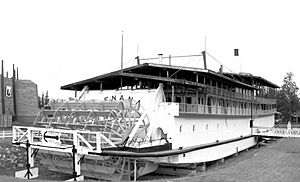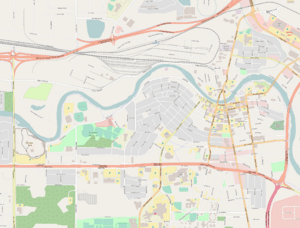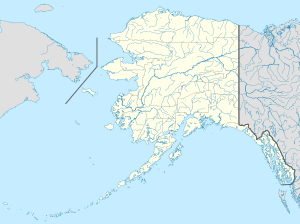Nenana (steamer) facts for kids

Nenana, sternwheeler, in Pioneer Park, Fairbanks, 2011
|
|
| History | |
|---|---|
| Builder | Berg Shipbuilding Company |
| Launched | 1933 |
| Out of service | 1957 |
| Status | Museum ship since 1965 |
| General characteristics | |
| Tonnage | 1,000 gross register tons (GRT) |
| Length | 237 ft (72 m) LOA |
| Beam | 42 ft (13 m) |
| Propulsion | Sternwheeler |
|
Nenana
|
|

S.S. Nenana in 1988
|
|
| Location | Pioneer Park, Fairbanks, Alaska |
| Area | less than one acre |
| Built | 1933 |
| Architect | Seattle Shipbuilding Company |
| NRHP reference No. | 72001581 |
| Significant dates | |
| Added to NRHP | 27 June 1972 |
| Designated NHL | 5 May 1989 |
The SS Nenana is a special kind of boat called a sternwheeler. It has a large paddle wheel at the back to move through the water. This boat has five decks and is very long, about 237 feet. It is also 42 feet wide.
The Nenana was built in Nenana, Alaska, and launched in May 1933. It was designed by W.C. Nickum from Seattle. The parts were made in Seattle and then put together in Alaska.
Contents
What the Nenana Did
The Nenana was built to carry both people and goods. It could hold 48 passengers on its saloon deck. The main deck could carry up to 300 tons of freight. This included two tons of items that needed to be kept cold.
Crew and Cargo Capacity
The boat had rooms for some of its 32 crew members. The Nenana was powerful enough to push many barges. It could push five or six barges on the Yukon River. However, on the Tanana River, it could only push one barge. This was because the Tanana River had very sharp turns.
Nenana During Wartime
During World War II, the Nenana was very busy. It helped supply military bases in Alaska. For example, it carried supplies to Galena Air Base. This base helped send fighter planes to the Soviet Union. The boat also moved supplies to other military places in Alaska.
After the War
After the war, fewer people traveled by river. The Alaska Railroad stopped all passenger services on the river after 1949. The Nenana was repaired in 1952. It made only one more trip for the Alaska Railroad.
Later, a new company called Yutana Barge Lines leased the boat in 1954. They used the Nenana to haul freight for one season. But they stopped using it because it was not making enough money.
Becoming a Museum Ship
In 1955, the government tried to sell the Nenana. A group from Fairbanks wanted to save the boat. This group, called Greater Fairbanks Opportunities, Inc., bought the steamboat. They moved it up the Tanana River and Chena River to Fairbanks.
In 1957, the Nenana opened as a museum ship. For a short time, it even worked as a hotel. This happened when there were not enough rooms in Fairbanks.
Protecting the Nenana
Over time, the Nenana started to get damaged. Weather, neglect, and people taking souvenirs caused problems. To protect it, the boat was moved in 1965. It was placed in a dry spot on land.
The Nenana became a main attraction at "Alaskaland". This is a historical park in Fairbanks. In 1972, it was added to the National Register of Historic Places. A big project began to make the boat look new again. Parts of the bow and decks have been rebuilt.
A National Historic Landmark
The Nenana is the only wooden sternwheeler of its kind still existing. Because of this, it was named a National Historic Landmark in 1989. Most of its original parts, about 70 to 90 percent, were still there at that time.
From the outside, the boat looks much like it did when it was working. Some parts of the inside have changed. But important areas, like the engine room, are still original. The Alaska Railroad first used the ship to move freight. It carried goods from the railroad yards in Nenana, Alaska to villages along the Yukon River and Tanana Rivers. Today, its history is shared with visitors at Pioneer Park, Fairbanks.
See also



